Abstract
Introduction:
Transverse deficiency of the maxilla is a common clinical problem in orthodontics and dentofacial orthopedics. Transverse maxillary deficiency, isolated or associated with other dentofacial deformities, results in esthetic and functional impairment giving rise to several clinical manifestations such as asymmetrical facial growth, positional and functional mandibular deviations, altered dentofacial esthetics, adverse periodontal responses, unstable dental tipping, and other functional problems. Orthopedic maxillary expansion is the preferred treatment approach to increase the maxillary transverse dimension in young patients by splitting of the mid palatal suture. This orthopedic procedure has lately been subject of renewed interest in orthodontic treatment mechanics because of its potential for increasing arch perimeter to alleviate crowding in the maxillary arch without adversely affecting facial profile. Hence, the present investigation was conducted to establish a correlation between transverse expansion and changes in the arch perimeter, arch width and arch length.
Methods:
For this purpose, 10 subjects (five males, five females) were selected who had been treated by rapid maxillary expansion (RME) using hyrax rapid palatal expander followed by fixed mechanotherapy (PEA). Pretreatment (T1), postexpansion (T2), and posttreatment (T3) dental models were compared for dental changes brought about by RME treatment and its stability at the end of fixed mechanotherapy. After model measurements were made, the changes between T1–T2, T2–T3 and T1–T3 were determined for each patient. The mean difference between T1–T2, T2–T3 and T1–T3 were compared to assess the effects of RME on dental arch measurements. Results are expressed as mean ± standard deviation and are compared by repeated measures analysis of variance followed by a post-hoc test. Arch perimeter changes are correlated with changes in arch widths at the canine, premolar and molar regions.
Results:
The intercanine arch width increased by 2.9 mm, inter first premolar width increased by 3.2 mm, inter second premolar width increased by 4.6 mm, intermolar width increased by 4.4 mm, arch perimeter increased by 3.2 mm, arch length decreased by 1.8 mm from pretreatment to posttreatment. There is a strong positive correlation of arch perimeter with intercanine width (r2 = 0.99), interpremolar width (r2 = 0.99) and intermolar width (r2 = 0.98), indicating that there is a significant increase in arch perimeter with increase in arch width at the canine, premolars and molar regions.
Conclusion:
Findings of this study demonstrate that there was a significant increase in the intercanine, inter first premolar, inter second premolar intermolar arch width and arch perimeter from pretreatment to postexpansion, which was stable at the end of fixed mechanotherapy (PEA). There was a nonsignificant decrease in arch length from pretreatment to postexpansion that further decreased nonsignificantly from postexpansion to posttreatment.
Keywords: Dental changes, hyrax expander, rapid maxillary expansion
Introduction
An intensive study of the growth of the human head will inevitably lead to the realization that it involves the most complicated anatomical complex in all creations. Growth is a complex phenomenon involving intricate interactions of three dimensions of space against the fourth dimension being time. Of the three dimensions, the transverse dimension is important in growth and development of the face and dentition since it is the first to be completed.[1]
Transverse deficiency of the maxilla is a common clinical problem in orthodontics and dentofacial orthopedics. Transverse deficiencies can be of skeletal or dental origin, and their etiology could either be genetic or environmental. Genetic factors account for hypoplastic maxilla in all dimensions along with a normal mandible. Environmental factors involve mouth breathing associated with posterior nasal blockage and oral habits.[2]
Transverse maxillary deficiency, isolated or associated with other dentofacial deformities, results in esthetic and functional impairment giving rise to several clinical manifestations such as asymmetrical facial growth, positional and functional mandibular deviations, altered dentofacial esthetics, adverse periodontal responses, unstable dental tipping, and other functional problems.[3] If this abnormality exists because of a real or relative disharmony in the maxillomandibular relationship, it is clear that a transverse maxillomandibular discrepancy is well-suited to orthopedic alteration.[3]
Orthopedic maxillary expansion is the preferred treatment approach to increase the maxillary transverse dimension in young patients by splitting of the mid palatal suture.[2] This orthopedic procedure has lately been subject of renewed interest in orthodontic treatment mechanics because of its potential for increasing arch perimeter to alleviate crowding in the maxillary arch without adversely affecting facial profile.[4]
Rapid maxillary expansion (RME) is a dramatic procedure with a long history. Orthopedic maxillary expansion treatments have been used for more than 140 years and have been popularized since the mid-1960s. E. C. Angell first reported on the procedure in 1860, and since then it has gone through periods of popularity and decline.[2,5] Many authors consider that widening of the midpalatal suture is a suitable method for treating maxillary arch size discrepancies. Haas, Isaacson Murphy, and Wertz advocated splitting of the midpalatal suture to widen narrow maxillary arches. In addition to the desirable transverse alterations, RME produces perceptible changes in the sagittal and vertical planes.[5]
Rapid maxillary expansion can be used to correct unilateral or bilateral posterior cross-bites, and it occurs when the forces applied to the teeth, and the maxillary alveolar process exceeds the limit needed for orthodontic tooth movement.[5]
Forces of large magnitude delivered during activation of an expansion screw open the intermaxillary suture, compresses the periodontal ligament, bends the alveolar process, gradually opens the mid palatal suture and separates the maxillary bones. The result is usually an increase in the upper arch transverse dimensions, mainly by the skeletal alteration associated with dental changes.[2,6]
Although the objective of orthopedic maxillary expansion treatment is to widen the constricted maxilla in narrowed palatal vault patients, it has been shown by many authors that there are additional benefits of this procedure. Expansion procedures have been widely used for gaining sufficient arch length to permit tooth alignment thereby alleviate crowding and restore proper occlusal form and function.[7] Skeletal response that accompanies RME in young patients redirects the developing posterior teeth into normal occlusion, corrects asymmetries of condylar position and eliminates both functional shifts and temporomandibular joint dysfunction. Dental response includes significant gain in maxillary intermolar width, arch perimeter and arch length. Furthermore, there is an increase in lower dental arch width followed by the maxillary dental arch expansion.[2,5]
When evaluating the efficacy of an orthopedic therapeutic procedure such as RME, a few aspects deserve particular consideration from a clinical point of view.[8]
The amount of correction of the initial disharmony
The differentiation between dentoalveolar and skeletal changes
Effectiveness of the treatment outcome in relation to treatment timing.
A task that many orthodontists undertake routinely is to create additional spaces in dental arches of dental crowding patients with tooth size-arch length discrepancies. Review of the literature supports the contention that the RME device, in addition to its other effects, can provide additional space in the arch to relieve crowding. The appliance, if used within certain age limits where indicated, is a useful adjunct to orthodontic treatment.[4]
Ratios between an increase in transverse dimension and changes in arch perimeter, arch width, and arch length are used in orthodontic treatment planning and are often associated with the decision to extract or not.
Therefore, it is of most interest to the clinician as to how much space can be gained in the dental arch by skeletal expansion of the maxilla using RME device. The purpose of this investigation is to determine the dental arch changes following RME and to correlate between transverse expansion and changes in the arch perimeter, arch width and arch length.
Methodology
A pilot study was carried out on five samples to estimate the mean differences before and after treatment and to verify the estimated sample size. Out of the pilot study following data was compiled:
Standard deviation (SD1 in pretest) =3.13 mm
Standard deviation (SD2 in posttest) =2.48 mm
Effect size = 0.85 mm
Power = 80%
α error = 5%.
For one-sided statistical test, we need minimum of 10 subjects. It is obtained from a sample size estimation software called “N”-master developed by Christian Medical College Vellore by feeding the above-mentioned data. The output is as follows [Table 1]:
Table 1.
Sample size estimation

Data collection
Ten patients (5 males and 5 females) treated with a hyrax rapid palatal expander followed by fixed mechanotherapy (PEA) were assessed using measurements obtained from pretreatment, postexpansion and posttreatment dental models to determine the changes in arch perimeter, arch width and arch length and determine the correlation between them [Figures 1-3]. The database for evaluation was obtained retrospectively from the file section of Department of Orthodontics and Dentofacial Orthopedics, Bapuji Dental College and Hospital, Davangere.
Figure 1.
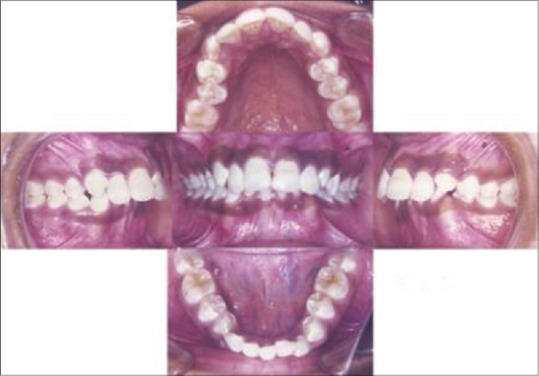
Pretreatment
Figure 3.
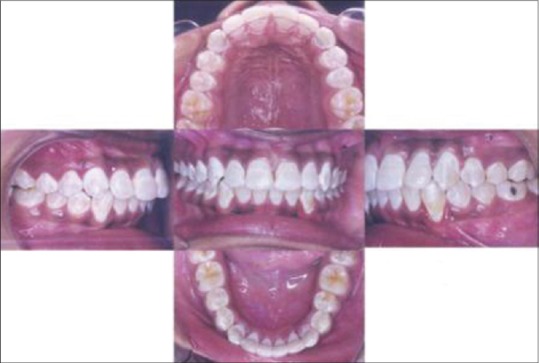
Posttreatment
Figure 2.
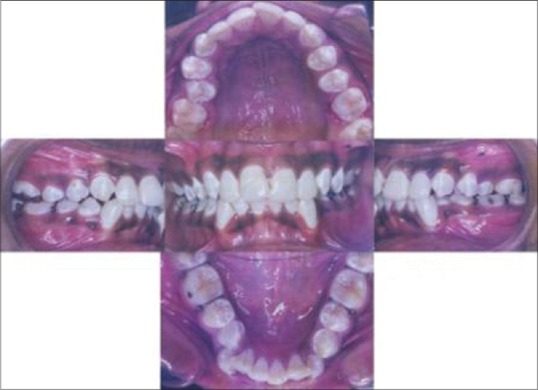
Postexpansion
Inclusion criteria's
All patients who require RME device on the basis of their individual treatment plan
Patients who are in the early permanent dentition phase
Patients with normal physiological growth.
Exclusion criteria's
Patients with missing teeth or anomalies in teeth number and size
Patients with craniofacial anomalies and stunted growth
Patients with muscular dysfunctions.
Materials used in the study
Pretreatment, postexpansion and posttreatment study models
KORKHAUS – three-dimensional bow divider (DENTAURUM [028-353-00] made in Germany).
Methods
Using the fine point KORKHAUS – three-dimensional bow divider widths of the anterior and posterior parts of the maxillary dental arch in the canine, premolar, first molar regions and length of the maxillary arch were measured. Maxillary arch perimeter was measured using a brass wire (23 gauge).
For intercanine width, the measurement was taken from the cusp tip of one side canine to the cusp tip of the other side canine, for the interpremolar width measurement was taken from mesial pit of one side premolar to the mesial pit of the other side premolar and for intermolar width, measurement was taken from the mesial occlusal pit of one side molar to the mesial occlusal pit of the other side molar. Arch length was measured as the perpendicular distance from the labial contact point between two central incisors to a line constructed between contact points mesial to the first permanent molar on either side. The orientation rod of the KORKHAUS Caliper was placed on the mid palatal suture, and the Caliper was placed parallel to the occlusal plane. Arch perimeter was measured using brass wire as the length of the segment connecting contact point mesial to first permanent molars, contact points mesial to first premolars and contact point distal to the central incisors.
Statistical analysis
The data obtained were analyzed for statistical significance using repeated measures analysis of variance followed by a post-hoc test. Arch perimeter changes were correlated with changes in arch widths at the canine, premolar and molar regions.
Results
Arch perimeter, arch length, arch width at the canine, first premolar, second premolar and first molar were measured on the study casts at pretreatment (T1), postexpansion (T2) and posttreatment (T3). Arch perimeter changes were correlated with changes in arch widths at the canine, premolar and molar regions.
Arch width changes
Inter canine width
The mean pretreatment intercanine width was 31.1 ± 2.07 mm, mean postexpansion intercanine width was 34.4 ± 2.31 mm and mean posttreatment intercanine width was 34.0 ± 1.24 mm. The mean difference from pretreatment to postexpansion was 3.3 mm with a P = 0.002 (S), from postexpansion to posttreatment was −0.4 mm with a P = 0.890 (not significant [NS]), from pretreatment to posttreatment was 2.9 mm with a P = 0.007 (S) [Table 2, Graph 1].
Table 2.
Dental arch changes from T1 (pretreatment) - T2 (postexpansion) - T3 (posttreatment)
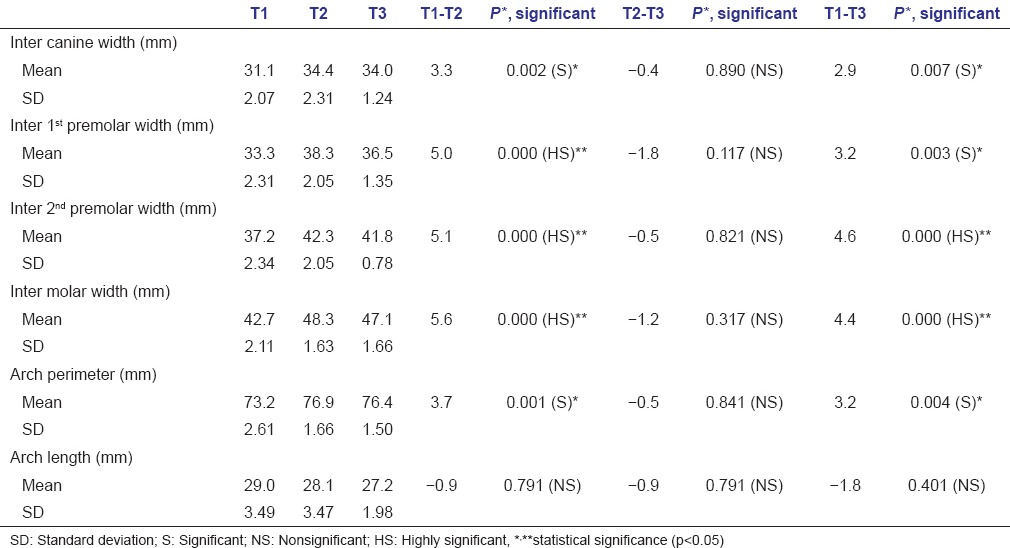
Graph 1.
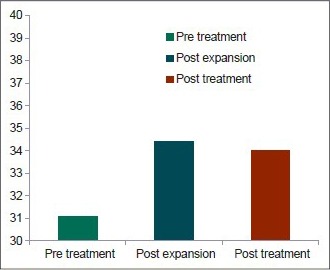
Inter canine arch width changes
Inter first premolar width
The mean pretreatment inter first premolar width was 33.3 ± 2.31 mm, mean postexpansion inter first premolar width was 38.3 ± 2.05 mm and mean posttreatment inter first premolar width was 36.5 ± 1.35 mm. The mean difference from pretreatment to postexpansion was 5.0 mm with a P = 0.000 (HS), from postexpansion to posttreatment was −1.8 mm with a P = 0.117 (NS), from pretreatment to posttreatment was 3.2 mm with a P = 0.003 (S) [Table 2, Graph 2].
Graph 2.
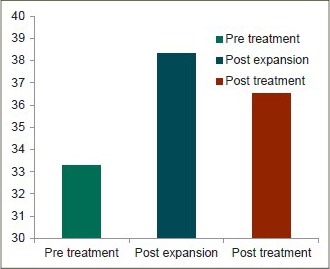
Inter first premolar arch width changes
Inter second premolar width
The mean pretreatment inter second premolar width was 37.2 ± 2.34 mm, mean postexpansion inter second premolar width was 42.3 ± 2.05 mm and mean posttreatment inter second premolar width was 41.8 ± 0.78 mm. The mean difference from pretreatment to postexpansion was 5.1 mm with a P = 0.000 (HS), from postexpansion to posttreatment was −0.5 mm with a P = 0.821 (NS), from pretreatment to posttreatment was 4.6 mm with a P = 0.000 (HS) [Table 2, Graph 3].
Graph 3.
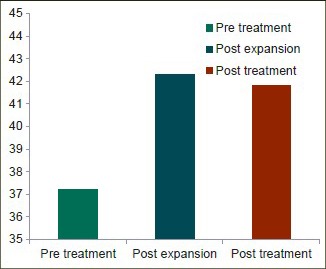
Inter second premolar arch width changes
Inter molar width
The mean pretreatment inter molar width was 42.7 ± 2.11 mm, mean postexpansion inter molar width was 48.3 ± 1.63 mm and mean posttreatment inter molar width was 47.1 ± 1.66 mm. The mean difference from pretreatment to postexpansion was 5.6 mm with a P = 0.000 (HS), from postexpansion to posttreatment was −1.2 mm with a P = 0.317 (NS), from pretreatment to posttreatment was 4.4 mm with a P = 0.000 (HS) [Table 2, Graph 4].
Graph 4.
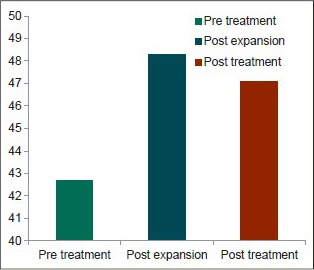
Inter molar arch width changes
Arch perimeter changes
The mean pretreatment arch perimeter was 73.2 ± 2.61 mm, mean postexpansion arch perimeter was 76.9 ± 1.66 mm and mean posttreatment arch perimeter was 76.4 ± 1.50 mm. The mean difference from pretreatment to postexpansion was 3.7 mm with a P = 0.001 (S), from postexpansion to posttreatment was −0.5 mm with a P = 0.841 (NS), from pretreatment to posttreatment was 3.2 mm with a P = 0.004 (S) [Table 2, Graph 5].
Graph 5.
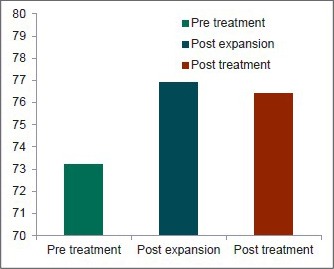
Arch perimeter changes
Arch length changes
The mean pretreatment arch length was 29.0 ± 3.49 mm, mean postexpansion arch length was 28.1 ± 3.47 mm and mean posttreatment arch length was 27.2 ± 1.98 mm. The mean difference from pretreatment to postexpansion was −0.9 mm with a P = 0.791 (NS), from postexpansion to posttreatment was −0.9 mm with a P = 0.791 (NS), from pretreatment to posttreatment was −1.8 mm with a P = 0.401 (NS) [Table 2, Graph 6].
Graph 6.
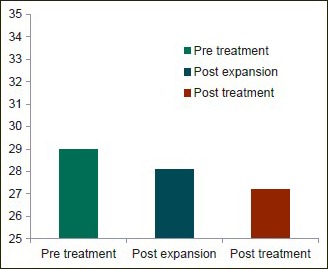
Arch length changes
Correlations
The r2 values for changes in arch perimeter and intercanine width was found to be 0.99 with P = 0.000 (HS). The r2 values for changes in arch perimeter and inter first premolar width was found to be 0.99 with P = 0.000 (HS). The r2 values for changes in arch perimeter and inter second premolar width was found to be 0.99 with P = 0.000 (HS). The r2 values for changes in arch perimeter and inter molar width was found to be 0.98 with P = 0.000 (HS).
Discussion
Extract or expand? These are the options for the orthodontist who must treat crowding of the teeth and inadequate dental arch space. Preferences have vacillated over the years between a strict nonextraction approach and extraction of teeth in majority of the cases.[9] Current trends in the practice of orthodontics have shifted toward the principles of dentofacial orthopedics and nonextraction treatment modalities. The use of orthopedic appliances has demonstrated skeletal and dental effects in the transverse, sagittal, and vertical dimensions. One of the most impressive orthopedic procedures is the transverse separation of the maxillae through RME. It was generally believed that RME procedures resulted in minimum tooth movement and maximum skeletal displacement. This procedure has lately been the subject of renewed interest in orthodontic treatment modalities because of its potential for increasing arch perimeter to alleviate crowding in the maxillary arch without adversely affecting facial profile.[4]
The principal goal of this study was to determine the dental arch changes following RME and fixed mechanotherapy (PEA) and to correlate changes in arch width with arch perimeter. The results of the present study indicate that there was a significant gain in intercanine arch width from pretreatment to postexpansion that was stable at the end of fixed mechanotherapy. These findings are in accordance with Adkins and Nanda,[4] Akkaya et al.,[10] McNamara et al.,[11] Aparecida et al.,[12] Cozzani et al.,[13] Mutinelli et al.[14] and Handelman et al.[15] Expansion was greater in the posterior segment of the arch as compared to anterior segments. Mossaz noted that the intercanine arch width showed a smaller increase than the intermolar width, contrary to these findings, it has been reported in the previous studies of Wertz 1970, Biedermann 1973, Ekstrom et al. 1977, Bell and Le-Compte 1981, Timms 1991[16] that the opening of mid palatal suture is greater in the anterior region than the posterior region.
However, the appliances used in the present study were not anchored to canines, which may be suspected to cause a smaller increase in the intercanine arch width.
There was a highly significant gain in interpremolar arch width from pretreatment to postexpansion that was stable at the end of fixed mechanotherapy. These findings are in accordance with Adkins and Nanda[4] who also found a mean increase of 6.1 mm in interpremolar width in their study. Handelman et al.[15] found a mean increase of 5.5 mm in the interpremolar width in his study. Moussa and O’Reilly,[17] Akkaya et al.,[10] McNamara et al.,[11] Cozzani et al.,[13] Canuto et al.,[18] Halicioglu et al.,[19] also found a similar increase in the interpremolar widths in their study.
There was a significant gain in intermolar arch width from pretreatment to postexpansion that was stable at the end of fixed mechanotherapy. These findings are in accordance with Adkins and Nanda[4] who found a mean increase of 6.5 mm in the intermolar width in their study. Moussa and O’Reilly,[17] Akkaya et al.,[10] McNamara et al.,[11] Aparecida et al.,[12] Mutinelli et al.,[14] Canuto et al.,[18] Handelman et al.[15] and Halicioglu et al.[19] also found a similar increase in the intermolar widths in their study.
There was a significant gain in archperimeter from pretreatment to postexpansion that was stable at the end of fixed line of treatment. These findings are in accordance with Adkins and Nanda[4] found a mean increase of 4.7 mm in arch perimeter in their study. Akkaya et al.[10] found a mean increase of 5.05 mm in arch perimeter following expansion in their study. Moussa and O’Reilly,[17] Aparecida et al.,[12] Mutinelli et al.,[14] Ferris and Alexander[20] also found a similar increase in archperimeter in their study.
There was a nonsignificant decrease in arch length from pretreatment to posttreatment. The decrease in arch length can be attributed to palatal movement of the maxillary incisors.[4] These findings are in accordance with Adkins and Nanda[4] who also found a decrease of 0.4 mm in arch length that was nonsignificant in their study. Mutinelli et al.[14] found a mean increase of 1.03 mm in arch length from pretreatment to postexpansion, however there was no significant difference from pretreatment to posttreatment in their study.
There was a strong positive correlation of arch perimeter with intercanine width (r2 = 0.99), interpremolar width (r2 = 0.99) and intermolar width (r2 = 0.98). These findings are in accordance with that of Akkaya et al.,[10] Adkins and Nanda[4] who also found a positive correlation of arch perimeter with interpremolar (r2 = 0.69) and intermolar width (r2 = 0.54).
The preadjusted edgewise appliance has limited the role in altering the transverse dimension since the arch wires are individualized and customized to the patients archform. In this study, the PEA appliance was used only for aligning and leveling the dentition following RME. The results also indicate that there was no statistically and clinically significant change in arch dimensions from postexpansion to posttreatment.
Conclusion
Dental arch changes brought about by RME followed by fixed orthodontic treatment were assessed, and the changes in arch width were correlated with changes in arch perimeter. The following conclusions were made from the study:
The intercanine arch width increased by 2.9 mm, inter first premolar width increased by 3.2 mm, inter second premolar width increased by 4.6 mm, intermolar width increased by 4.4 mm, arch perimeter increased by 3.2 mm, arch length decreased by 1.8 mm from pretreatment to posttreatment. Although there was some amount of relapse seen from postexpansion to posttreatment, it was not statistically and clinically significant
There is a strong positive correlation of arch perimeter with intercanine width (r2 = 0.99), interpremolar width (r2 = 0.99) and intermolar width (r2 = 0.98), indicating that there is a significant increase in arch perimeter with increase in arch width at the canine, premolars and molar
These findings indicate that arch expansion can gain significant amount of increase in arch perimeter thereby aiding the clinician to treat borderline cases with nonextraction mode of therapy.
Footnotes
Source of Support: Nil.
Conflict of Interest: None declared.
References
- 1.Schudy FF. The rotation of the mandible resulting from growth: Its implications in orthodontic treatment. Angle Orthod. 1965;35:36–50. doi: 10.1043/0003-3219(1965)035<0036:TROTMR>2.0.CO;2. [DOI] [PubMed] [Google Scholar]
- 2.Al-Battikki R. Rapid maxillary expansion: Review of literature. Saudi Dent J. 2001;13:161–7. [Google Scholar]
- 3.Lima AL, Lima Filho RM, Bolognese AM. Long-term clinical outcome of rapid maxillary expansion as the only treatment performed in Class I malocclusion. Angle Orthod. 2005;75:416–20. doi: 10.1043/0003-3219(2005)75[416:LCOORM]2.0.CO;2. [DOI] [PubMed] [Google Scholar]
- 4.Adkins MD, Nanda RS, Currier GF. Arch perimeter changes on rapid palatal expansion. Am J Orthod Dentofacial Orthop. 1990;97:194–9. doi: 10.1016/S0889-5406(05)80051-4. [DOI] [PubMed] [Google Scholar]
- 5.Bishara SE, Staley RN. Maxillary expansion: Clinical implications. Am J Orthod Dentofacial Orthop. 1987;91:3–14. doi: 10.1016/0889-5406(87)90202-2. [DOI] [PubMed] [Google Scholar]
- 6.Daniela GG, Henriques JF. Longitudinal effects of rapid maxillary expansion a retrospective cephalometric study. Angle Orthod. 2007;77:442–8. doi: 10.2319/0003-3219(2007)077[0442:LEORME]2.0.CO;2. [DOI] [PubMed] [Google Scholar]
- 7.Lagravere MO, Major PW, Flores-Mir C. Long-term dental arch changes after rapid maxillary expansion treatment: A systematic review. Angle Orthod. 2005;75:155–61. doi: 10.1043/0003-3219(2005)075<0151:LDACAR>2.0.CO;2. [DOI] [PubMed] [Google Scholar]
- 8.Baccetti T, Franchi L, Cameron CG, McNamara JA., Jr Treatment timing for rapid maxillary expansion. Angle Orthod. 2001;71:343–50. doi: 10.1043/0003-3219(2001)071<0343:TTFRME>2.0.CO;2. [DOI] [PubMed] [Google Scholar]
- 9.Lutz HD, Poulton DR. Stability of dental arch expansion in the deciduous dentition. Angle Orthod. 1985;55:299–315. doi: 10.1043/0003-3219(1985)055<0299:SODAEI>2.0.CO;2. [DOI] [PubMed] [Google Scholar]
- 10.Akkaya S, Lorenzon S, Uçem TT. Comparison of dental arch and arch perimeter changes between bonded rapid and slow maxillary expansion procedures. Eur J Orthod. 1998;20:255–61. doi: 10.1093/ejo/20.3.255. [DOI] [PubMed] [Google Scholar]
- 11.McNamara JA, Jr, Baccetti T, Franchi L, Herberger TA. Rapid maxillary expansion followed by fixed appliances: A long-term evaluation of changes in arch dimensions. Angle Orthod. 2003;73:344–53. doi: 10.1043/0003-3219(2003)073<0344:RMEFBF>2.0.CO;2. [DOI] [PubMed] [Google Scholar]
- 12.Aparecida CC, Abrão J, Reis SA, de Fantini SM. Correlation between transverse expansion and increase in the upper arch perimeter after rapid maxillary expansion. Braz Oral Res. 2006;20:76–81. doi: 10.1590/s1806-83242006000100014. [DOI] [PubMed] [Google Scholar]
- 13.Cozzani M, Guiducci A, Mirenghi S, Mutinelli S, Siciliani G. Arch width changes with a rapid maxillary expansion appliance anchored to the primary teeth. Angle Orthod. 2007;77:296–302. doi: 10.2319/0003-3219(2007)077[0296:AWCWAR]2.0.CO;2. [DOI] [PubMed] [Google Scholar]
- 14.Mutinelli S, Cozzani M, Manfredi M, Bee M, Siciliani G. Dental arch changes following rapid maxillary expansion. Eur J Orthod. 2008;30:469–76. doi: 10.1093/ejo/cjn045. [DOI] [PubMed] [Google Scholar]
- 15.Handelman CS, Wang L, BeGole EA, Haas AJ. Non-surgical rapid maxillary alveolar expansion in adults: A clinical evaluation. Angle Orthod. 1997;67:291–308. doi: 10.1043/0003-3219(1997)067<0291:NRMAEI>2.3.CO;2. [DOI] [PubMed] [Google Scholar]
- 16.Timms DJ. The dawn of rapid maxillary expansion. Angle Orthod. 1999;69:247–50. doi: 10.1043/0003-3219(1999)069<0247:TDORME>2.3.CO;2. [DOI] [PubMed] [Google Scholar]
- 17.Moussa R, O’Reilly MT, Close JM. Long-term stability of rapid palatal expander treatment and edgewise mechanotherapy. Am J Orthod Dentofacial Orthop. 1995;108:478–88. doi: 10.1016/s0889-5406(95)70048-x. [DOI] [PubMed] [Google Scholar]
- 18.Canuto LF, de Freitas MR, Janson G, de Freitas KM, Martins PP. Influence of rapid palatal expansion on maxillary incisor alignment stability. Am J Orthod Dentofacial Orthop. 2010;137:164.e1–6. doi: 10.1016/j.ajodo.2009.06.017. [DOI] [PubMed] [Google Scholar]
- 19.Halicioglu K, Kiliç N, Yavuz I, Aktan B. Effects of rapid maxillary expansion with a memory palatal split screw on the morphology of the maxillary dental arch and nasal airway resistance. Eur J Orthod. 2010;32:716–20. doi: 10.1093/ejo/cjp164. [DOI] [PubMed] [Google Scholar]
- 20.Ferris T, Alexander RG, Boley J, Buschang PH. Long-term stability of combined rapid palatal expansion-lip bumper therapy followed by full fixed appliances. Am J Orthod Dentofacial Orthop. 2005;128:310–25. doi: 10.1016/j.ajodo.2005.01.001. [DOI] [PubMed] [Google Scholar]


